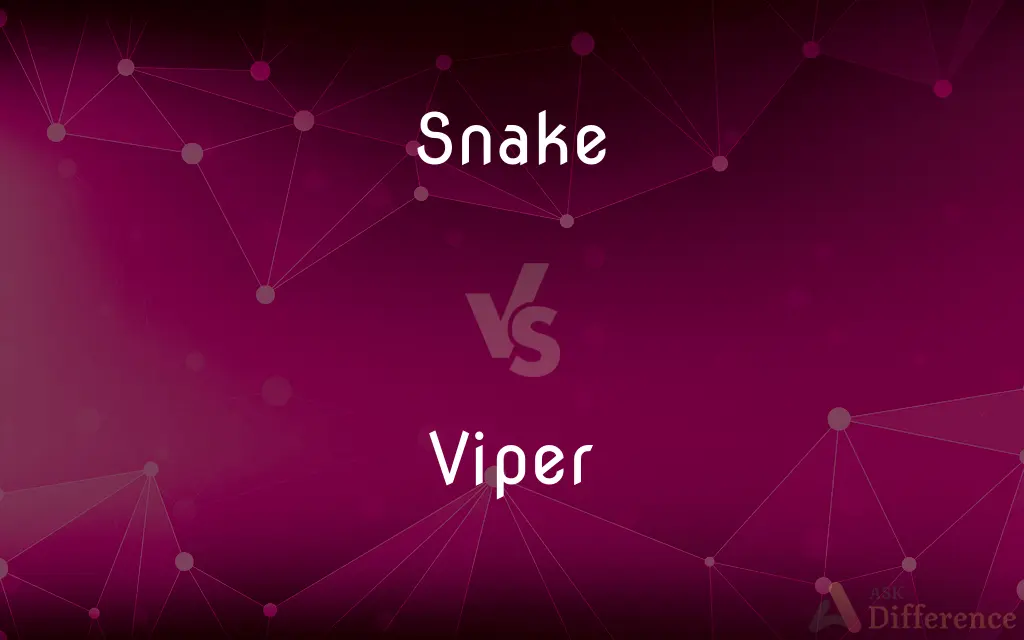Snake vs. Viper — What's the Difference?
By Fiza Rafique & Maham Liaqat — Updated on March 24, 2024
A snake is a limbless reptile within the suborder Serpentes, while a viper is a specific family of venomous snakes known for their long fangs and potent venom.

Difference Between Snake and Viper
Table of Contents
ADVERTISEMENT
Key Differences
Snakes encompass a wide variety of limbless reptiles, ranging from the harmless garden snake to the deadly cobra, characterized by their elongated bodies and lack of limbs. Vipers, on the other hand, are a specific group within this broad category, distinguished by their venomous bite, hinged fangs, and a sensory pit in pit vipers.
While snakes can be found in diverse habitats around the world, from forests to deserts, vipers are particularly noted for their presence in varied environments but with a concentration in Eurasia and Africa. Some snakes, such as pythons and boas, are constrictors that kill their prey by suffocation, whereas vipers typically immobilize their prey with a quick, venomous bite.
The diet of snakes varies widely, with some species eating insects, while others may consume mammals, birds, or even other snakes. Vipers primarily prey on small animals, using their venom to subdue them quickly before consumption.
Snakes reproduce in various ways, including laying eggs, live birth, or a combination of both, depending on the species. Vipers predominantly give birth to live young, a trait known as viviparity, which is relatively uncommon among reptiles.
In terms of human interaction, while many snakes are harmless and even beneficial by controlling pest populations, vipers are often considered dangerous due to their potent venom, which can be fatal to humans without prompt treatment.
ADVERTISEMENT
Comparison Chart
Classification
Broad category of limbless reptiles within the suborder Serpentes.
Specific family of venomous snakes, known for long fangs and potent venom.
Habitat
Diverse, including forests, deserts, oceans, and freshwater.
Varied, with many species found in Eurasia and Africa.
Hunting Method
Varies widely; includes constricting and venomous bites.
Uses venomous bite to quickly immobilize prey.
Diet
Insects, mammals, birds, fish, and other snakes, depending on the species.
Primarily small mammals, birds, and other small animals.
Reproduction
Egg-laying, live birth, or ovoviviparity, depending on the species.
Predominantly viviparous, giving birth to live young.
Human Interaction
Many species are harmless; some are beneficial for pest control.
Often considered dangerous due to potent venom; some species pose significant risks to humans.
Compare with Definitions
Snake
Reproduction methods among snakes vary, including egg-laying and live birth.
The sea snake gives birth to live young, adapted to its aquatic life.
Viper
A family of venomous snakes known for their efficient hunting method using potent venom.
The Russell's viper, found in Asia, is responsible for many snakebite incidents.
Snake
Plays a crucial role in many ecosystems by controlling rodent and insect populations.
Farmers often welcome non-venomous snakes for their role in pest control.
Viper
Characterized by hinged fangs that allow deep venom injection.
Vipers can control the amount of venom injected during a bite, depending on the threat.
Snake
A diverse group of limbless reptiles with various feeding and habitat preferences.
The garden snake, common in many habitats, primarily feeds on insects.
Viper
Often found in specific regions, with a notable presence in Eurasia and Africa.
The European adder is a viper species commonly found across Europe.
Snake
While some species are venomous, the majority pose no threat to humans.
Most snake encounters are harmless, with venomous species being less common.
Viper
Vipers give birth to live young, a trait that distinguishes them from many other snakes.
The common viper avoids egg predation by giving birth to live offspring.
Snake
Can employ different hunting strategies, from constricting to using venom.
The king cobra, a venomous snake, can deliver a fatal bite to its prey.
Viper
Due to their venom potency, vipers are respected and often feared in human-populated areas.
In regions with viper populations, communities take precautions to avoid snake encounters.
Snake
Snakes are elongated, limbless, carnivorous reptiles of the suborder Serpentes . Like all other squamates, snakes are ectothermic, amniote vertebrates covered in overlapping scales.
Viper
Any of various venomous snakes of the family Viperidae, having a thick heavy body and a single pair of long hollow fangs, especially the Eurasian and African species of the subfamily Viperinae, which lack the sensory pits of the pit vipers.
Snake
See Shoshone.
Viper
Any of several harmless snakes sometimes believed to be venomous.
Snake
See Hydra.
Viper
A person regarded as malicious or treacherous.
Snake
Any of numerous scaly, legless, sometimes venomous squamate reptiles of the suborder Serpentes (or Ophidia), having a long, tapering, cylindrical body and flexible jaws.
Viper
A venomous snake in the family Viperidae.
Snake
A treacherous person. Also called snake in the grass.
Viper
(informal) Any venomous snake.
Snake
A long, highly flexible metal wire or coil used for cleaning drains. Also called plumber's snake.
Viper
(figurative) A dangerous, treacherous, or malignant person.
Snake
To drag or pull lengthwise, especially to drag with a rope or chain.
Viper
(slang) A person who smokes marijuana.
Snake
To pull with quick jerks.
Viper
Any one of numerous species of Old World venomous snakes belonging to Vipera, Clotho, Daboia, and other genera of the family Viperidæ.
There came a viper out of the heat, and fastened on his hand.
Snake
To move in a sinuous or gliding manner
Tried to snake the rope along the ledge.
Viper
A dangerous, treacherous, or malignant person.
Who committedTo such a viper his most sacred trustOf secrecy.
Snake
To move with a sinuous motion
The river snakes through the valley.
Viper
Loosely, any venomous or presumed venomous snake.
Snake
A legless reptile of the suborder Serpentes with a long, thin body and a fork-shaped tongue.
Viper
Venomous Old World snakes characterized by hollow venom-conducting fangs in the upper jaw
Snake
A treacherous person; a rat.
Snake
Somebody who acts deceitfully for social gain.
Snake
A tool for unclogging plumbing.
Snake
A tool to aid cable pulling.
Snake
(Australia) A flavoured jube (confectionary) in the shape of a snake.
Snake
(slang) Trouser snake; the penis.
Snake
(maths) A series of Bézier curves.
Snake
(cartomancy) The seventh Lenormand card.
Snake
An informer; a rat.
Gem’s a snake for Kamale, man.
Snake
(intransitive) To follow or move in a winding route.
The path snaked through the forest.
The river snakes through the valley.
Snake
To steal slyly.
He snaked my DVD!
Snake
(transitive) To clean using a plumbing snake.
Snake
To drag or draw, as a snake from a hole; often with out.
Snake
(nautical) To wind round spirally, as a large rope with a smaller, or with cord, the small rope lying in the spaces between the strands of the large one; to worm.
Snake
(MLE) To inform; to rat.
He says he didn't snake and I believe him.
Snake
Any species of the order Ophidia; an ophidian; a serpent, whether harmless or venomous. See Ophidia, and Serpent.
Snake
To drag or draw, as a snake from a hole; - often with out.
Snake
To wind round spirally, as a large rope with a smaller, or with cord, the small rope lying in the spaces between the strands of the large one; to worm.
Snake
To crawl like a snake.
Snake
Limbless scaly elongate reptile; some are venomous
Snake
A deceitful or treacherous person
Snake
A tributary of the Columbia River that rises in Wyoming and flows westward; discovered in 1805 by the Lewis and Clark Expedition
Snake
A long faint constellation in the southern hemisphere near the equator stretching between Virgo and Cancer
Snake
Something resembling a snake
Snake
Move smoothly and sinuously, like a snake
Snake
Form a snake-like pattern;
The river snakes through the valley
Snake
Move along a winding path;
The army snaked through the jungle
Common Curiosities
What should you do if bitten by a viper?
If bitten by a viper, it's critical to seek immediate medical attention, as viper venom can be highly toxic and life-threatening.
Are all snakes venomous?
No, not all snakes are venomous. Many species are harmless to humans, and only a subset, including vipers, possess venom.
How can you identify a viper?
Vipers can often be identified by their distinctive triangular head, keeled scales, and the presence of long, hinged fangs.
Do snakes play an important role in the ecosystem?
Yes, snakes are crucial in ecosystems as both predators and prey, helping to control pest populations and serving as food for other wildlife.
How do snakes sense their environment?
Snakes sense their environment through a combination of sight, smell, and vibrations. They also have a specialized organ called the Jacobson's organ for detecting chemical cues.
Are vipers found in Australia?
Vipers are not native to Australia; the venomous snakes in Australia are primarily from the Elapidae family, such as the taipan and brown snake.
How do vipers deliver their venom?
Vipers deliver venom through their long, hinged fangs, which allow them to inject venom deeply into their prey.
What's the difference between snake venom and poison?
Venom is injected via a bite or sting, while poison is ingested or absorbed. Snakes deliver venom through fangs, whereas poisonous creatures, like some frogs, contain toxins in their skin.
Do all snakes lay eggs?
No, not all snakes lay eggs. Some, like many vipers, give birth to live young.
How do vipers use their venom?
Vipers use their venom primarily for hunting, immobilizing their prey before consumption, and secondarily for defense.
Can snakes be found in urban areas?
Yes, some snake species have adapted to urban environments and can be found in gardens, parks, and near human dwellings.
Can a snake survive without venom?
Yes, many snake species are non-venomous and rely on constriction or other means to capture prey.
Share Your Discovery

Previous Comparison
Attachment vs. Addendum
Next Comparison
Strong vs. MildAuthor Spotlight
Written by
Fiza RafiqueFiza Rafique is a skilled content writer at AskDifference.com, where she meticulously refines and enhances written pieces. Drawing from her vast editorial expertise, Fiza ensures clarity, accuracy, and precision in every article. Passionate about language, she continually seeks to elevate the quality of content for readers worldwide.
Co-written by
Maham Liaqat















































